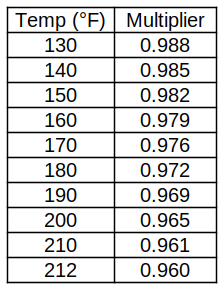Hello,
I need to measure the most accurate grain absorption in my BIAB system, but the total grain weight I currently have allows only a regular batch and a leftover that I thought of doing this measurement, only reducing the scale to that.
I learned an equation (initial volume - volume post_mash / grain weight) and I was wondering if a small-scale measurement would give me a result equal to use the normal volume of a regular mash.
Example: calculate the grain absorption using only 100g (3.5 oz) of grain in 1 liter (1 quart) of water give me a usefull grain absorption result similar to a large scale calculation?
Has anyone ever done that?
Thank you.
I need to measure the most accurate grain absorption in my BIAB system, but the total grain weight I currently have allows only a regular batch and a leftover that I thought of doing this measurement, only reducing the scale to that.
I learned an equation (initial volume - volume post_mash / grain weight) and I was wondering if a small-scale measurement would give me a result equal to use the normal volume of a regular mash.
Example: calculate the grain absorption using only 100g (3.5 oz) of grain in 1 liter (1 quart) of water give me a usefull grain absorption result similar to a large scale calculation?
Has anyone ever done that?
Thank you.
Last edited:




















![Craft A Brew - Safale BE-256 Yeast - Fermentis - Belgian Ale Dry Yeast - For Belgian & Strong Ales - Ingredients for Home Brewing - Beer Making Supplies - [3 Pack]](https://m.media-amazon.com/images/I/51bcKEwQmWL._SL500_.jpg)








































